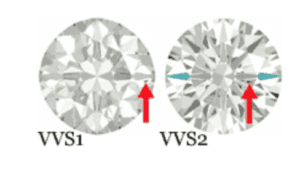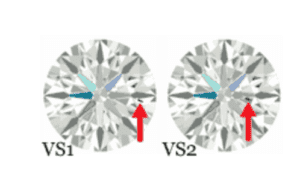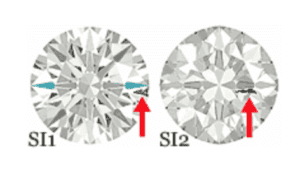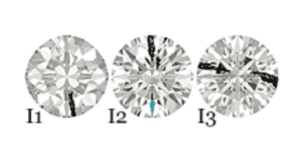How Are Diamonds Made? Natural vs Lab-Created Explained
Two Paths, One Diamond Not all diamonds come from the same place — but they all start the same way. Pure carbon, crystalized under immense pressure and heat. Whether it…
This month we’re focusing on Diamond Clarity and where you can make compromises to find a stone that suits your taste and budget. Diamond Clarity is part of the four characteristics of a diamond better known as the 4 C’s: Cut, Carat Weight, Color, and Clarity. A grading metric was developed by the Gemological Institute of America (GIA) to help consumers determine the overall value and quality of their diamonds. The GIA Clarity scale includes 11 clarity grades ranging from Flawless to I3. Flawless indicates that there are no inclusions or blemishes visible at 10X magnification. A grade I3 is for diamonds with inclusions that are obvious to the naked eye.
Inclusions are the imperfections in the diamond. Size and visibility of inclusions determine diamond clarity. The majority of diamonds have some sort of inclusions, a flawless clarity rating exists however they are very rare. Many diamonds have inclusions that you can’t really see with the naked eye so embracing the fact that most diamonds have inclusions means to pick a stone with the right inclusions.
There are various factors that determine the clarity grade of a diamond. The main factors include: The Number of Imperfections- How many Imperfections are in a Diamond?; Location of Imperfections- Where in the Diamond are these Imperfections located? and the Visibility of Imperfections- How easy can you see these Imperfections?
Clarity grades are measured by examining the polished diamond face-up at 10X magnification in neutral white LED lighting. When graded, F and IF indicate the diamond is Flawless, or Internally Flawless; showing no inclusions at 10X magnification.
VVS1 and VVS2 indicate Very Very Slight inclusions; only the most minute imperfections were detected.

VS1 and VS2 imply Very Slight inclusions; the grader saw only minor characteristics.

SI1 and SI2 grades indicate the diamond was Slightly Included; inclusions were notable under 10X magnification.

I1 means Included; characteristics were obvious to the grader when magnified. I2 and I3 grades are reserved for diamonds with extremely obvious inclusions and/or durability issues caused by their clarity features.

The overall clarity of the diamond is important because it has an impact on the level of transparency and beauty emitting from the diamond. However, Clarity is the least important characteristic amongst the 4 C’s when compared to Cut and Carat weight. We tend to tell our members that clarity is really a personal preference and is dependent on the use of the diamond.
The larger the diamond, the easier imperfections are to detect therefore clarity becomes important. The most popular range is the VS1-VS2 diamond as seen in our Most Popular Diamond Search. These diamonds appear flawless to the naked eye and are a fraction of the price of a flawless diamond. For diamonds over 2 carats, a clarity grade of VS2 or higher is the safest bet for avoiding any signs of visible inclusions. In diamonds between 1 and 2 carats, clarity grades of SI1 or lower will not have inclusions easily visible to the naked eye. For example, if you’re purchasing a diamond for an engagement ring where people will be viewing the diamond closeup you want to go with a VS1 – VS2 but if you’re purchasing diamonds for a pair of diamond studs or earrings you can save some money by opting for SI1 diamonds.
Clarity is graded on a scale measured from F to I3 with a Flawless diamond showing no inclusions under 10X magnification and I3 with showing an extreme amount of inclusions. Your diamond doesn’t have to be flawless, to be flawless as you can get away with a VS1 – SI1 diamond which is clean to the naked eye. You can get the most value for your money by purchasing SI1s. For more information on diamond clarity, read the Clarity Guide found in our Knowledge section.
Written By Bianca Mac Donald of PriceScope Inc.